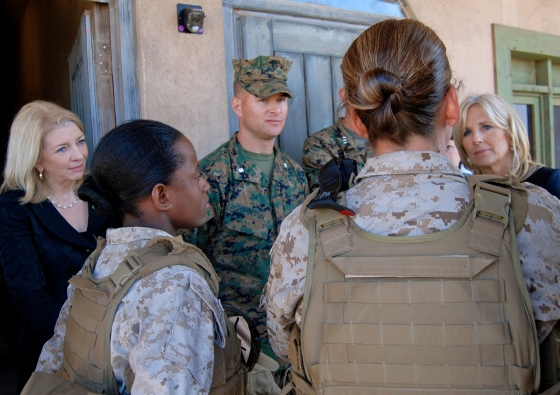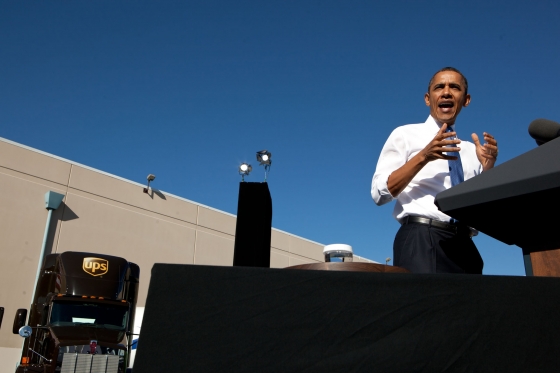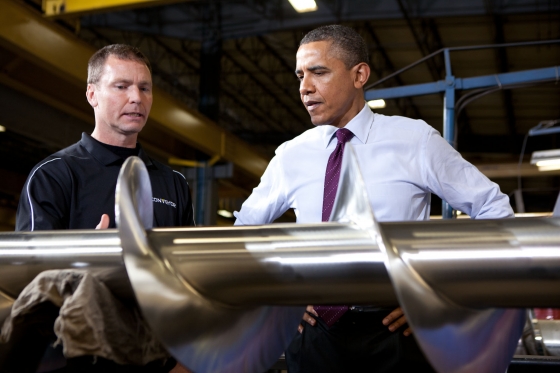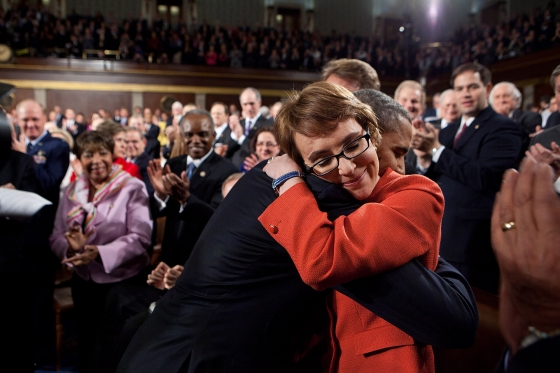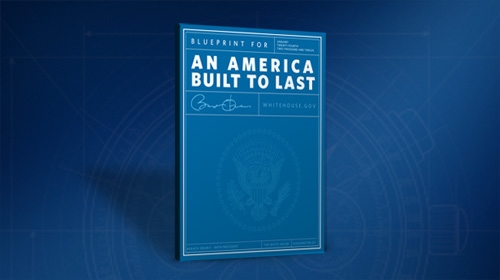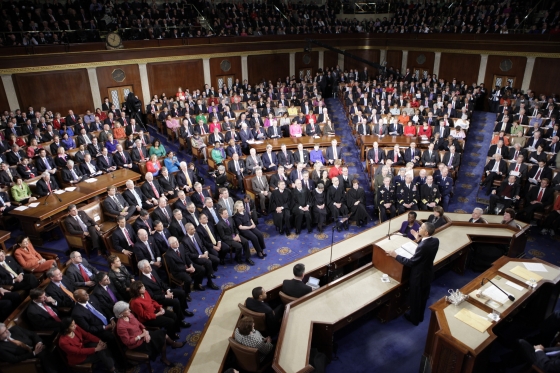-
This week, the President prepared for and delivered his State of the Union Address, welcomed the Boston Bruins to the White House, and took his message West to Iowa, Arizona, Nevada, and Colorado.
-
Last Friday, I was honored to spend the day with Marines and families preparing for deployment at Marine Corps Base Camp Pendleton. It was a very special day. As Second Lady, there is nothing I enjoy more than visiting our military and their families. I am honored that they share their successes, pride, and challenges with me, and that when I bring their concerns back to the White House, they help shape policy. But as a military mom, these visits are also personal. Each Marine I met on Friday is someone’s son or daughter, and I know well the mixture of pride and worry a family member feels when a loved one is preparing to go to war.
In the morning, I visited with Marines in combat training at the Infantry Immersion Trainer. I viewed a combat simulation exercise at the state-of-the art facility that is designed to resemble an Afghan village, down to every detail. The training is intended to prepare deploying Marines for the stress of combat. The visit made a deep and lasting impression on me, and it was a firm reminder of what our troops and their families sacrifice for us every single day – half a world away. After the simulation, I met with Female Engagement Team members preparing to deploy to Afghanistan. These young women go on foot patrols with Marine infantry units on the front lines in Afghanistan to interact with Afghan women and girls. I was inspired by their courage and determination, and their pride in what they do.
Our next stop was Family Day with members of the Explosive Ordinance Disposal Company and their families. The EOD team performs missions in extremely dangerous conditions, and they have very high injury rates. Almost all of the EOD team members I met are married, and many have young children – who also sacrifice every day while their Marines are in harm’s way. After lunch, I stopped at the EOD “hero wall,” a photo memorial honoring fallen Marines and Sailors. I will never forget their faces. One Marine – speaking of a fallen warrior – told me “he saved my life.”
-
President Obama toured a UPS facility in Las Vegas today to talk about the future of energy in America.
First, he discussed the progress we've already made:
For decades, Americans have been talking about how do we decrease our dependence on foreign oil. Well, my administration has actually begun to do something about it.
Over the last three years, we negotiated the toughest new efficiency standards for cars and trucks in history. We’ve opened millions of new acres for oil and gas exploration. Right now, American oil production is the highest that it’s been in eight years. Eight years. Last year, we relied less on foreign oil than in any of last 16 years. That hasn’t gotten a lot of attention, but that’s important. We’re moving in the right direction when it comes to oil and gas production.
-
This week, senior White House officials have been answering your questions about President Obama’s State of the Union Address through a series of Office Hours on Twitter. Miss the speech? Visit Whitehouse.gov/SOTU to watch and learn more and then check out the full line up of engagement events below.
You can ask a question using the hashtag #WHChat and don’t forget to follow along with the conversation all day at @WHLive.
Missed a session? Click on the chat below to check out the full Q&A on Storify.
-
Back in December, thousands of Americans shared their stories about the impact that losing $40 per paycheck would have on them, and on their families, if Congress did not pass the payroll tax cut.
Responses poured in from across the country, and these stories made a difference: Congress passed and President Obama signed a two-month extension of the payroll tax cut for middle class families before it expired at the end of 2011.
Amber Morris from Virginia Beach, Virginia was one of the people who wrote in to say what losing $40 per paycheck would mean to her, and on Tuesday night she joined First Lady Michelle Obama for the President’s State of the Union Address. Amber was selected to represent the tens of thousands of Americans who made their voices heard during the debate.
-
This afternoon, Vice President Biden answered questions tweeted by people across the country in his first-ever Twitter interview. From an advanced manufacturing facility in Rochester, New Hampshire, the Vice President answered your questions about taxes, the DREAM act and even his Super Bowl pick.
-
In his State of the Union address on Tuesday night, and again today at a UPS facility in Las Vegas, President Obama said that the country needs an “all-out, all of the above strategy that develops every available source of American energy—a strategy that’s cleaner, cheaper, and full of new jobs.”
We’ve taken steps to reduce our dependence on foreign oil and today, American oil production is at its highest level in eight years. In 2011, we relied less on foreign oil than in any of the past 16 years.
 With less than 2 percent of the world’s oils reserves, however, the United States must find new ways to produce the energy we need. We’ve nearly doubled our use of renewable energy in the past few years, and are back on top as the world’s leading investor in clean energy. But more can and must be done to further develop our own energy resources and transition to cleaner sources of energy.
With less than 2 percent of the world’s oils reserves, however, the United States must find new ways to produce the energy we need. We’ve nearly doubled our use of renewable energy in the past few years, and are back on top as the world’s leading investor in clean energy. But more can and must be done to further develop our own energy resources and transition to cleaner sources of energy.President Obama has laid out a Blueprint for an energy strategy that does just that. His plan, which relies on American-made energy and the skills of American workers, will improve our national security, grow our economy, and create jobs, while making sure our environment and the health of our citizens aren’t put at risk.
Safely developing American oil and gas resources
Domestic oil and natural gas production has increased every year President Obama has been in office. In 2011, U.S. crude oil production reached its highest level since 2003, and U.S. natural gas production eclipsed the previous recordset in 1973. Total oil and gas production on public lands during the first three years of the Obama Administration increased by 13 percent compared with the last three years of the previous administration, and today, the United States has more oil and gas rigs operating than the rest of the world—combined
President Obama’s all-of-the-above strategy focuses on continuing to develop these resources:

Developing our natural gas supply: The United States is the world’s leading producer of natural gas, and we have a nearly 100-year supply of it. President Obama has directed his administration to safely develop this gas, called shale gas, in a way that will create up to 600,000 jobs by the end of the decade, according to independent experts. He also called for new rules requiring companies to disclose the chemicals they use when accessing and removing shale gas on public lands to make sure public health is protected.
Expanding offshore oil and gas development: At President Obama’s directive, the Department of Interior is working to finalize a national offshore energy plan that opens new areas for drilling in the Gulf of Mexico and Alaska, making 75 percent of our potential offshore oil and gas resources available for development. In the wake of the Deepwater Horizon tragedy, new projects in the Gulf of Mexico must now meet strict drilling and workplace safety standards, implemented to help avoid another massive oil spill.
Modernizing pipeline infrastructure: President Obama directed agencies to approve and expedite pipeline projects that will move oil and gas from domestic drilling sites to refineries quickly and efficiently while protecting the health and safety of nearby communities and environments.
Committing to clean energy
In the near term, the U.S. will continue to rely on responsibly produced oil and gas. Over the long term, however, the Obama Administration is committed to a policy that builds on progress to transition from oil toward cleaner alternatives and energy efficiency.
The Obama Administration has already made the largest investment in clean energy in history. Nearly 40 clean energy projects supported by the Department of Energy are expected to employ more than 60,000 Americans, generate enough clean electricity to power nearly 3 million homes and replace nearly 300 million gallons of gasoline annually. These projects include the world’s largest wind farm, the first new U.S. nuclear plant in three decades, and several of the largest solar power generation facilities. But we must do more to accelerate this progress.
Implementing a clean energy standard: The centerpiece of President Obama’s plan to develop and use more clean energy calls for establishing a “clean energy standard," which would require utility companies to produce a larger percentage of their electricity from clean energy sources over time --including renewable sources such as wind, solar, biomass, hydropower, and nuclear, among others. With this requirement in place, clean sources would account for 80 percent of our electricity by 2035. Besides reducing carbon emissions, implementing a standard would create a larger domestic market for developing new, innovative energy technologies—and the many jobs that would come along with it.
Establishing targeted tax incentives: To further support a growing clean energy industry, President Obama’s energy strategy calls for renewing and extending a number of already successful tax incentives. This includes tax incentives for clean energy manufacturing, which could create up to 100,000 jobs, and the Production Tax Credit to support investment in the deployment of clean energy technologies. President Obama is also calling for an end to the $4 billion in taxpayer-funded subsidies that Congress gives each year to oil companies, which are currently bringing in record profits.
-
To follow up on his State of the Union speech, I would like to highlight a few key points about the legislation the President mentioned that we sent to the Congress last May to secure our country from the growing danger of cyber-threats.
From day one, the President’s charge to all of us in the Administration has been to do everything possible to address our critical national and economic security needs. That is why we have tried to aggressively use our existing authorities to address the cybersecurity vulnerabilities of the critical infrastructure systems upon which we as a nation rely for our security and prosperity.
While there is much the Administration can and will continue to do under existing legal authorities to improve our nation’s cybersecurity, only Congress can modernize our underlying laws and give us the full range of tools our cybersecurity professionals need to more effectively deal with this growing and increasingly sophisticated threat. To address these growing risks and at the invitation of congressional leaders, the Administration sent the Congress a package of legislative proposals in May 2011 to give the federal government new authority to ensure the corporations that own the assets most critical to our nation’s security and economic prosperity are adequately addressing the risks we as a nation all share. Additionally, our proposals would provide new tools to help our citizens and law enforcement professionals defend against cyber crime and identity theft, while, at the same time, safeguarding individuals’ privacy and civil liberties. Further, our proposals would give the federal government new authority to share information about cyber threats with businesses, and when asked, provide them with federal assistance to prevent attacks and defend against the theft of intellectual property, which, when stolen, erodes their corporate competitive advantages among global peers and our competitiveness as a nation.
-
Since the end of 2009, business investment has grown by a rate of 18 percent, and exports have increased by 32 percent -- for a total of $2 trillion.
That's good news for American manufacturing, which has added 334,000 jobs in the past two years.
Last night, in the State of the Union, President Obama said that his Blueprint for an America that lasts begins with manufacturing. He talked about the revival of the American auto industry and said that what is happening in Detroit can happen in Cleveland, Pittsburgh, or Raleigh.
To achieve that vision, the President focused on three key themes.
-

In 2011, American businesses created the most jobs in any year since 2005. In fact, the private sector has added nearly 3.2 million jobs in the last 22 months.
These numbers are proof that we are steadily climbing out of the worst economic downturn since the Great Depression. But we can’t stop now. We must continue to take steps to strengthen and grow our economy.
In his State of the Union address last night, President Obama outlined a Blueprint for an American economy built to last. He laid out a plan to create jobs in the manufacturing and clean energy industries that relies on the skills of American workers. And ee called for a return to American values: hard work, responsibility, and the same rules for everyone, from Wall Street to Main Street.
-
First Lady Michelle Obama and Agriculture Secretary Tom Vilsack today introduced new rules that mean America’s school children will soon be eating healthier lunches in the cafeteria.
The new USDA guidelines, which implement important provisions of the Healthy, Hunger-Free Kids Act of 2010, substantially increase the amount of fruits, vegetables, and whole grains on the menu, while reducing saturated fat, trans fats and sodium, and set calorie limits based on the age of children being served. The standards make the same kinds of practical changes that many parents are already encouraging at home, and that are a key pillar of Let's Move, the First Lady's initiative that is focused on improving child nutrition and reducing childhood obesity.
Speaking at the Parklawn elementary school in Alexandria, VA, Mrs Obama praised parents for their contribution to the movement to improve the food served in schools:
When we send our kids to school, we have a right to expect that they won’t be eating the kind of fatty, salty, sugary foods that we're trying to keep from them when they're at home. We have a right to expect that the food they get at school is the same kind of food that we want to serve at our own kitchen tables.
After the press conference, the First Lady and Secretary Vilsack joined students for a healthy lunch of turkey tacos, black bean and corn salad and fresh fruit, prepared by celebrity chef Rachael Ray.
-
January 25, 2012
01:50 PM EDTInternational trade is vital to the American economy and supports our way of life. Businesses today have global footprints and are supported by an ever evolving global supply chain system. As a number of recent events remind us, this system is dynamic and complex but also vulnerable to numerous threats. These threats, such as pandemics, natural disasters, or attacks involving weapons of mass destruction could undermine the continuity of the global supply chain system as a whole. Also, because of the interconnectedness of the system, even smaller, localized events could escalate rapidly and cause significant disruptions.
Today, with the announcement of the National Strategy for Global Supply Chain Security, we take an important step to strengthen and protect this vital system. The Strategy, focused on the worldwide network of transportation, postal, and shipping assets and supporting infrastructures, articulates our national vision and approach, and encourages collaborative implementation with key State, local, tribal, territorial, private sector and international stakeholders.
-
Last night, the team from the White House Photo Office was on hand to document the 2012 State of the Union, and they've put together a great new slide show.
Learn more
- Watch the enhanced version of the 2012 State of the Union Address
- Read President Obama's Blueprint for an America Built to Last
- Take a deep dive into the data behind the President’s plan
- Find out how you can talk to Obama Administration officials about the President's plan
-
Americans who watched an online broadcast of President Obama's 2012 State of the Union address saw something a little different: a side by side display of charts, graphs and other visual representations of why the President's policies are so important for our country and our economy. You can see the slides here, or download them at slideshare
-
Update: The Twitter interview will now take place at 1:10 p.m. EST on Thursday, January 26.
POTUS is right, we need an America built to last. Join me to discuss #SOTU in my 1st @Twitter chat 1/26, 1:30pm ET. Use #WHChat to ask Qs-VP
— Office of VP Biden (@VP) January 25, 2012
Following the State of the Union Address, President Obama and more than thirty administration officials will be responding to your questions about the speech and talking to you about the issues that you care the most about. We're excited to announce that Vice President Biden will also be joining the schedule of engagement opportunities with the White House around the State of the Union.
On Thursday, January 26th, Vice President Biden will answer questions submitted by people from across the country in his first Twitter interview, live from an advanced manufacturing facility in Rochester, New Hampshire. Earlier on Thursday, the Vice President will deliver remarks to workers there about the Administration’s efforts to promote partnerships between community colleges and businesses to train skilled workers for the jobs of the future.
Here's how you can participate:
- Starting now, ask questions for the Vice President and administration officials on Twitter using the hashtags #SOTU and #WHchat.
- On Thursday, January 26th, at 1:10p.m. EST the folks at Twitter will select some of the most popular questions for the Vice President to answer.
- Follow the whole interview on Twitter live through the @gov handle. The Vice President's responses will be tweeted from the @VP account.
Be sure to follow @VP on Twitter for the latest from the Vice President's office. We hope you'll join the conversation with the Vice President on Thursday, and check out all the ways you can engage with the White House at WhiteHouse.gov/sotu.
-
Tonight, as President Obama wrapped up his State of the Union, he said, "As long as we are joined in common purpose, as long as we maintain our common resolve, our journey moves forward, and our future is hopeful, and the state of our Union will always be strong."
Throughout the speech, he discussed ideas for building an America that lasts. He called it a blueprint for the future and talked about ways to make his vision reality. Learn more about those ideas.
Miss something the President said? To read the full remarks, go here. Or watch the video.
Want to get more out of the enhanced version of the State of the Union? Check out the slides after the jump.
-
Tonight, the President outlined a series of ideas to build an economy that works for everyone, one that will bring about a new era of American manufacturing, and promote homegrown and alternative energy sources.
Taken together, those ideas represent a blueprint for the future.
For decades, economic security for the middle class has been unraveling. Jobs that were once the source of stable livelihoods were shipped overseas. Those at the very top watched their incomes skyrocket, while the majority of Americans were stuck with stagnant salaries and rising costs. And all of this was happening before the worst economic crisis in generations.
What's it going to take to address this crisis?
We need to promote new skills and better education so that all Americans are prepared to compete in a global economy. That's why, tonight, the President said every state should require all students to stay in high school until they earn a diploma or turn 18. That's why the President called for a new partnership between community colleges and businesses to help train and place 2 million skilled workers.
-
As President Obama spoke tonight, the phrase he returned to again and again was "building an America that lasts."
We've put together a Blueprint that outlines the ideas in tonight's State of the Union and shows what it will take to achieve that vision. Check it out.
Right now, a group of policy experts and senior White House staff are discussing the speech and answering your questions on WH.gov/live.
And later tonight, we'll share video of the President's remarks and a transcript so you can read every line.
Be sure to check back.
Learn more
- Read President Obama's Blueprint for an America Built to Last
- Take a deep dive into the data behind the President’s plan
- Watch the enhanced version of the 2012 State of the Union Address
- Find out how you can talk to Obama Administration officials about the President’s plan
- Video: Go behind the scenes as the President prepared his speech
-
For nearly three decades, extraordinary Americans who exemplify the themes and ideals laid out in the State of the Union Address have been invited to join the First Lady in her viewing box. From teachers to small business owners and innovators, to health care reform beneficiaries and those serving in our armed forces – use the interactive feature below to learn more about the remarkable individuals who will join First Lady Michelle Obama tonight for the 2012 State of the Union Address.
Check out WhiteHouse.gov/sotu for an enhanced viewing experience of President Obama's State of the Union address and for opportunities to engage online with White House officials and even President Obama himself.
Read the full press release here.
Learn more about the 2012 State of the Union:
- Watch the enhanced version of the 2012 State of the Union Address
- Read President Obama’s Blueprint for an America Built to Last
- Take a deep dive into the data behind the President’s plan
- Video: Go behind the scenes as the President prepared his speech
- Find out how you can talk to Obama Administration officials about the President’s plan
- Photo Gallery: Scenes from the State of the Union
- &lsaquo previous
- 1
- 2
- 3
- 4
- 5
- 6
- 7
- 8
- 9
- …
- next &rsaquo









